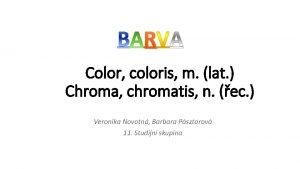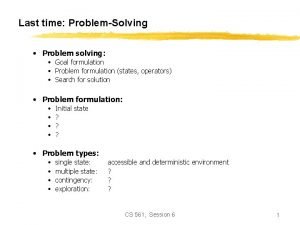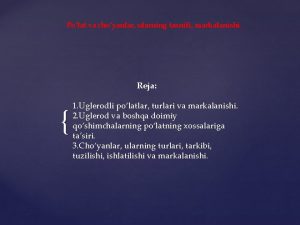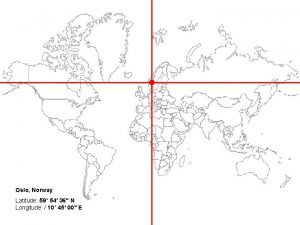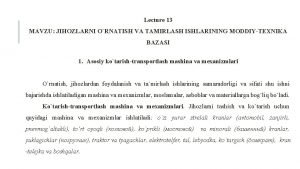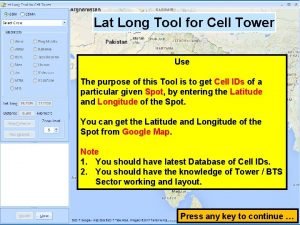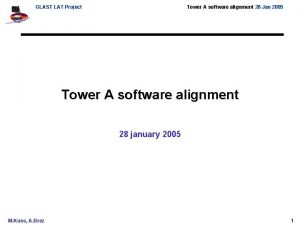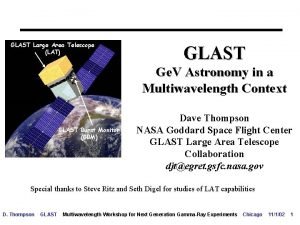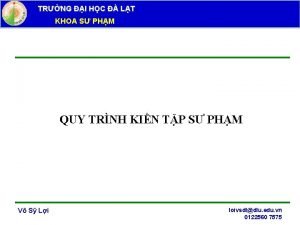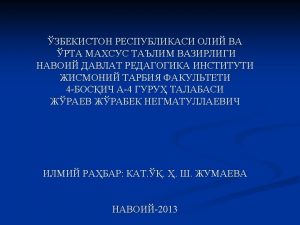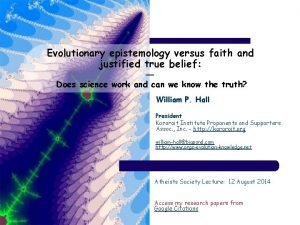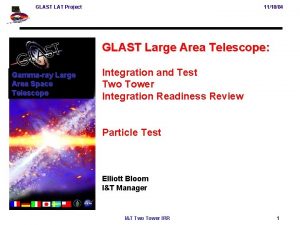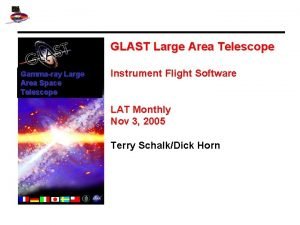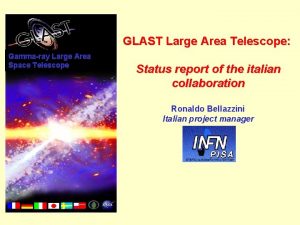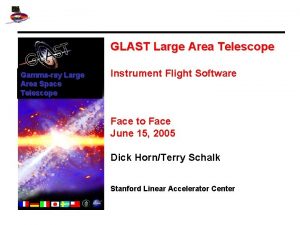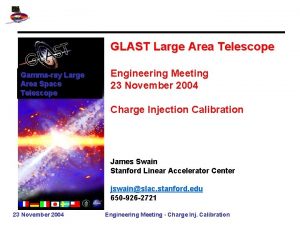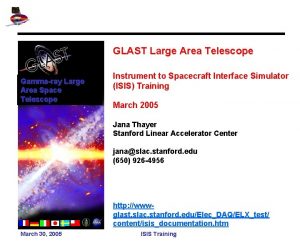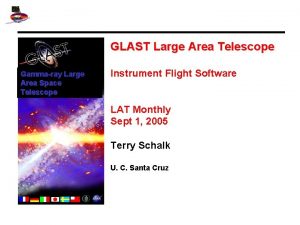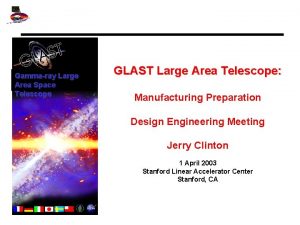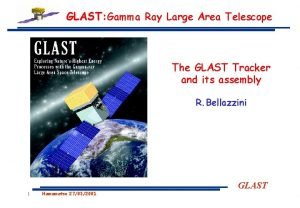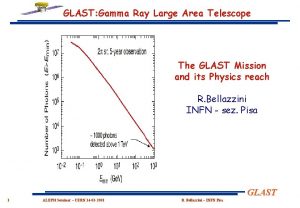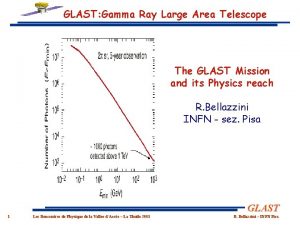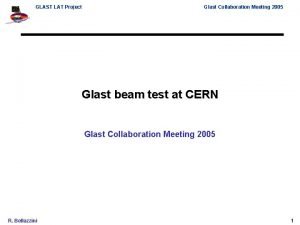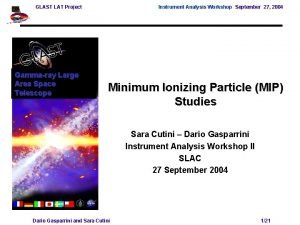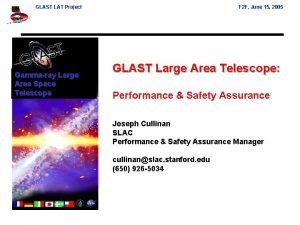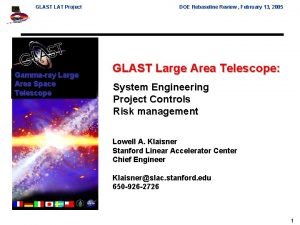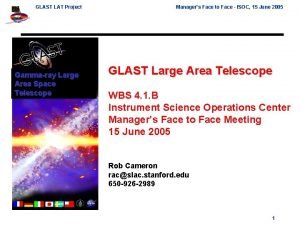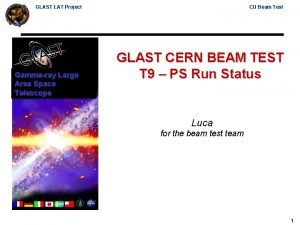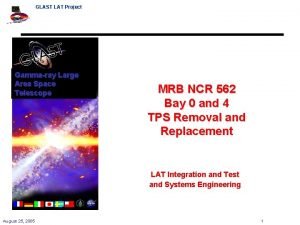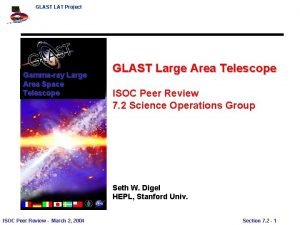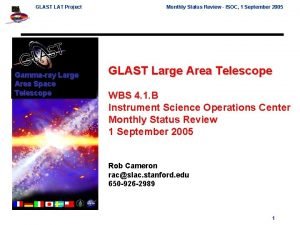GLAST Large Area Telescope LAT Mission Formulation Jonathan






















- Slides: 22

GLAST Large Area Telescope (LAT) Mission Formulation Jonathan Ormes Project Scientist Jonathan. F. Ormes@nasa. gov GLAST Burst Monitor (GBM) GLAST Users Group GSFC, October 22, 2003

Mission Objectives • Understand the mechanisms of particle acceleration in astrophysical environments such as active galactic nuclei, pulsars and supernova remnants • Determine the high energy behavior of gamma-ray bursts and other transients • Resolve and identify point sources with known objects • Probe dark matter and the extra-galactic background light in the early universe J. F. Ormes 2 Mission Formulation Users 2003, October 22

GLAST: DOE and NASA Partnership Department of Energy Office of Science NASA - Office of Space Science Chart the evolution of the universe, from origins to destiny Understand the nature of matter at the most fundamental level and to explore the evolution and fate of the universe through fundamental interactions of energy, matter, time and space. 1. Understand the structure of the universe 2. Explore the ultimate limits of gravity and energy in the universe 3. Learn how galaxies, stars and planets form, interact and evolve Particle physics Astronomy/astrophysics Gamma ray Large Area Space Telescope (GLAST) An astro-particle physics partnership to explore the highenergy universe J. F. Ormes 3 Mission Formulation Users 2003, October 22

GLAST is an International Mission NASA - Do. E Partnership on LAT is being built by an international team Si Tracker: Stanford, UCSC, Japan, Italy Cs. I Calorimeter: NRL, France, Sweden Anticoincidence: GSFC Data Acquisition System: Stanford, NRL GBM is being built by US and Germany Detectors: MPE Sweden Germany J. F. Ormes 4 Italy USA France Japan Mission Formulation Users 2003, October 22

GLAST Project Organization Project Manager K. Grady EPO Manager L. Cominsky Deputy Project Manager A. Vernacchio Project Scientist J. Ormes DPM/R M. Seidleck Deputy Project Scientists Steve Ritz/Neil Gehrels Secretary L. Barbour Financial Mgr. L. Tall Res Analyst vacant Contract Officer J. Edmond PSM W. Hensley CM J. Chipouras Schedules M. Walsh Library M. Rich Data Mgmt/PS B. Townsend MOGS Mgr. M. Rackley MOC Mgr. D. Small Observatory Mgr. J. Bretthauer Systems A. Guha Systems Manager J. Leibee Systems: R. Cox E. Canevari B. Wagner SSC Mgr. J. Norris Science Lead D. Band Flt Software E. Andrews P. Versteegen Launch Services Mgr. M. Goeser C. Mako (KSC) Mission Systems N. Rioux Systems: M. Melton T. Ford C. Connor B. Garnett Power – E. Gaddy Instrument Sys Mgr. Sys Assurance Mgr. T. Venator R. Kolecki Systems A. Whipple LAT Instr GBM Instr Mgr B. Graf B. Browne On-site Sys – J. Ku ACD I/F – S. Mengers CDH – J. Sonsino ACS – E. Stoneking Comm – P. Acosta, G. Humphrey Propulsion – M. Underdown Fantano Thermal – T. Mc. Carthy, L. Electrical – F. Blanchette Contamination – C. Lorentsen Structures/Mechanism – S. Seipel F. Tahmasebi C. Fransen Science Working Group QE T. Alvarez Parts T. Perry S/W QE D. Harmon Safety Mgr. D. Bogart J. Anderson Reliability T. Di Venti LAT On-site T. Shepherd S/C On-site M. Kunda I&T – E. Shippey Original signed Kevin Grady GLAST Project Manager J. F. Ormes 5 Mission Formulation September 9, 2003 Users 2003, October 22

Science Requirements • High Energy Gamma Rays: 20 Me. V - > 300 Ge. V – Source location <0. 5 arcmin • High latitude source of 10 -7 cm-2 s-1 flux, E-2 spectrum, – 1 radius, after 1 yr survey – Point source sensitivity < 6 x 10 -9 cm-2 s-1 • High latitude source after 1 yr survey, 5 detection – Background to be < 10% of extragalactic high latitude diffuse emission • Conduct broad band study of gamma ray bursts – Determine burst spectra from <10 ke. V to ~30 Ge. V – Determine burst locations <15 degrees and send to the GRB notification network (GCN) within 7 seconds J. F. Ormes 6 Mission Formulation Users 2003, October 22

Mission Requirements and Observing Plan • Spacecraft – Pointing knowledge < 10 arcseconds (1 ) – Observatory is designed to “point anywhere, anytime” • Operate without pointing at the Earth • Reorient quickly and autonomously to follow a transient or respond to a target of opportunity – Slew 75 degrees in 10 minutes – 3 normal operational modes • Scan (baseline) • Inertial pointing • Scan pointing - takes advantage of the wide field of view to optimize time on sky • Mission Lifetime 5 years, Goal 10 years (subject to Senior Review) – Observatory checkout 30 -60 days – First year is scanning to make all sky survey • Planned observations subject to interruption for extraordinary transients – Second year and beyond - operational mode driven by competitive proposals J. F. Ormes 7 Mission Formulation Users 2003, October 22

Guest Investigator Program • GI program starts during the survey – 10 -15 GIs • Will grow to ~100 Guest Investigations funded by NASA each year. • GLAST Fellows program • Continue Interdisciplinary Scientist (IDS) Program C. Dermer (NRL) - non-thermal universe B. Dingus (Los Alamos) - transients M. Pohl (Iowa State U. ) - diffuse galactic S. Thorsett (UCSC) - pulsars • Program of Education and Public Outreach continues throughout the mission J. F. Ormes 8 Mission Formulation Users 2003, October 22

Science Review History Highlights • Selected as mission concept study, 1994 (PI: Michelson, Stanford) • Endorsed by Gamma-Ray Astronomy Program Working Group as highest priority in gamma-ray astronomy, 1996 • Chosen as top priority (with Constellation-X) by Structure and Evolution of the Universe Subcommittee, 1997 • Reviewed by SAGENAP, presented to HEPAP, and approved by Do. E, 1998 • Science Requirements Document, Document drafted by Facility Science Team, signed in July 1999. • NASA AO: August 1999. Selections: February-March 2000. • GLAST is the highest-ranked Moderate Size space- based initiative in the National Academy of Sciences 2000 Decadal Survey Report. J. F. Ormes 9 Mission Formulation Users 2003, October 22

GLAST Instruments Large Area Telescope (LAT) PI: Peter Michelson Stanford University Photon Direction: Si SSD T� racker GLAST Burst Monitor (GBM) PI: Charles Meegan Marshall Space Flight Center Background rejection: Anti-coincidence Detectors 1. 8 m Energy: Calorimeter J. F. Ormes 10 Mission Formulation Users 2003, October 22

Large Area Telescope Parameters CGRO/EGRET GLAST/LAT Change 20 Me. V - 30 Ge. V 20 Me. V - > 300 Ge. V 10 to 300 Ge. V 0. 1 1500 cm 2 10, 000 cm 2 6. 6 0. 5 sr 2. 4 sr 4. 8 5. 8° @ 100 Me. V 0. 5° @ 10 Ge. V ~ 3. 5° @ 100 Me. V ~ 0. 1° @ 10 Ge. V Area = 1/2. 7 Area = 1/25 ~ 10 -7 cm-2 s-1 ~ 3 10 -9 cm-2 s-1 1/30 Deadtime 100 ms <10 s >5 Mass 1810 kg 3000 kg 1991 - 1997 2006 - 2016 Energy Range Energy Resolution (DE/E) Effective Area (1 Ge. V) Field of View Angular Resolution Sensitivity (> 100 Me. V)* Lifetime * 1 year survey at high latitudes Increased area, field of view, angular resolution, extended energy range and operational efficiency provide a powerful combination! J. F. Ormes 11 Mission Formulation Users 2003, October 22

GLAST Burst Monitoring • • LAT and GBM work synergistically to make new GRB observations GBM provides low-energy context measurements with high time resolution – – – Broad-band spectral sensitivity Contemporaneous low-energy & highenergy measurements Continuity with current GRB knowledge-base (GRO-BATSE) • Provides rapid GRB timing & location triggers w/Fo. V > LAT Fo. V – – – J. F. Ormes 12 Improved sensitivity and response time for weak bursts Follow particularly interesting bursts for afterglow observations Provide rapid locations for ground/space follow-up Mission Formulation Users 2003, October 22

Science Topics • Active Galactic Nuclei • Isotropic Diffuse Background Radiation • Cosmic Ray Production: – Molecular Clouds – Supernova Remnants – Normal Galaxies • Endpoints of Stellar Evolution – Neutron Stars/Pulsars – Black Holes • • Unidentified Gamma-ray Sources Dark Matter Solar Physics Gamma-Ray Bursts J. F. Ormes 13 Mission Formulation Users 2003, October 22

From EGRET to GLAST (>100 Me. V) • Map the gamma-ray sky with sensitivity > 30 times that of EGRET without becoming source confusion limited. GLAST CGRO/EGRET Virgo region Total Mission All-Sky Map (E > 100 Me. V) J. F. Ormes 14 Mission Formulation Users 2003, October 22

GLAST Project Master Schedule • Instrument preliminary Design Reviews completed • Spacecraft contractor selected: Spectrum-Astro – S/C PDR May 2003 • Critical Design Reviews for instruments – Held LAT May 2003 – GBM June 2004 • CDR for Spacecraft scheduled for spring 2004 • Instrument deliveries in 2005 – GBM fall – LAT December • Launch in Feb 2007 J. F. Ormes 15 Mission Formulation Users 2003, October 22

GLAST Ground System User community J. F. Ormes 16 Mission Formulation Users 2003, October 22

Earth Avoidance for Pointed Observations Rotation of Earth’s Disk Spacecraft Centered Celestial Sphere Inertial Target Orbit Plane 60 o dia FOV 134 o dia Earth Disk After Occultation Before Occultation • • Earth’s disk is approaching from the left FOV is losing inertial target J. F. Ormes 17 Mission Formulation Earth’s disk is receding to the right FOV is picking up inertial target Users 2003, October 22

Scan-pointing J. F. Ormes 18 Mission Formulation Users 2003, October 22

GLAST Mission Overview J. F. Ormes 19 Mission Formulation Users 2003, October 22

Summary of Capabilities • Huge FOV (20% of sky) allows primarily scanning operations • Opens unexplored region > 10 Ge. V • Unprecedented PSF for gamma rays (factor 5 better than EGRET at 10 Ge. V) • Expect to find new classes of gamma-ray sources with the improved sensitivity • No expendables potential for long mission without degradation • Large sensitive area (> 6 EGRET) for transients • Quick reaction to gamma-ray bursts and other transients J. F. Ormes 20 Mission Formulation Users 2003, October 22

GBM Capabilities BATSE GBM - Requirement GBM - Current Design Energy Range 25 ke. V – 10 Me. V <10 ke. V – >25 Me. V 6 ke. V - 30 Me. V Field of View All sky not occulted by Earth >8 sr 8. 7 sr Energy Resolution <10% (0. 1 -1. 0 Me. V, 1 on-axis) 7% (100 ke. V) 5% (1 Me. V) < 10 s/event 2. 5 s/event <0. 5 cm-2 s-1 0. 45 cm-2 s-1 <1. 0 cm-2 s-1 0. 78 cm-2 s-1 Deadtime Burst Sensitivity Ground (5 , 50 -300 ke. V) 0. 2 cm-2 s-1 Burst Sensitivity On-board (5 , 50300 ke. V, 50% efficiency) GRB Alert Location ~25 - <15 GRB Final Location 1. 7 - <1. 5 <2 s 2 s (arbitrarily selectable, trade-off between speed & accuracy) GRB Notification Time to Spacecraft J. F. Ormes 21 Mission Formulation Users 2003, October 22

LAT Capabilities EGRET LAT - Requirement LAT - Current Design Energy Range 20 Me. V – 30 Ge. V 20 Me. V – 300 Ge. V 20 Me. V - 300 Ge. V Energy Resolution 10 % <10%, 0. 1– 100 Ge. V (1 , onaxis) ~9%, 0. 1– 100 Ge. V Effective Area 1500 cm 2 >8000 cm 2 (maximum value, 110 Ge. V) 10, 000 cm 2 at 10 Ge. V Point Source Sensitivity (5 , >100 Me. V) ~1 10 -7 cm-2 s-s <6 10 -9 cm-2 s-2 (at high gal. latitude for 1 -year sky survy, for photon index of -2) 3 10 -9 cm-2 s-2 Angular Resolution 5. 8 (100 Me. V) <3. 5 (100 Me. V) <0. 15 (>10 Ge. V) 3. 4 (100 Me. V) 0. 086 (>10 Ge. V) Source Location Determination 15 arcmin <0. 5 arcmin (1 radius, flux 10 -7 cm-2 s-1 at 100 Me. V, high gal latitude) 0. 4 arcmin Field-of-view 0. 5 sr >2 sr 2. 4 sr Timing Accuracy 100 s <10 s TBD Deadtime 100 ms/event <100 s/event TBD GRB Location Accuracy On. Board <10 arcmin 5 arcmin GRB Notification Time to Spacecraft <5 s TBD J. F. Ormes 22 Mission Formulation Users 2003, October 22
 Glast tm
Glast tm Rubra fusca flava alba
Rubra fusca flava alba Why problem formulation follow goal formulation
Why problem formulation follow goal formulation Large volume parental
Large volume parental Dwie koparki pracując razem wykonują wykop w ciągu 8 dni
Dwie koparki pracując razem wykonują wykop w ciągu 8 dni Lat dorsi action
Lat dorsi action Pani asia kupiła 7 bułek
Pani asia kupiła 7 bułek Po'lat turlari
Po'lat turlari Oslo longitude and latitude
Oslo longitude and latitude Latissimus dorsi innervation
Latissimus dorsi innervation Lat prayers
Lat prayers Urnordiskan
Urnordiskan Latitude santos
Latitude santos Gruppdynamik faser
Gruppdynamik faser Zanjirga ulangan katta po'lat ilgak
Zanjirga ulangan katta po'lat ilgak Color 08242005
Color 08242005 Lat
Lat Ge lat
Ge lat Thêu lát khoán vảy
Thêu lát khoán vảy Khoa sư phạm đại học đà lạt
Khoa sư phạm đại học đà lạt Suyaklarning sinishi va chiqishida birinchi yordam
Suyaklarning sinishi va chiqishida birinchi yordam Tà áo năm xưa xanh màu thông đà lạt
Tà áo năm xưa xanh màu thông đà lạt Medo-lat epistemology
Medo-lat epistemology

